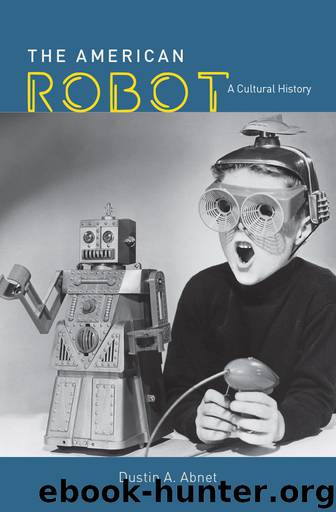The American Robot by Dustin A. Abnet

Author:Dustin A. Abnet
Language: eng
Format: epub
Tags: HIS000000 History / General
Publisher: University of Chicago Press
Published: 2020-03-29T16:00:00+00:00
The Totalitarian Robot
When Silberman and Blank tried to revive R.U.R. in 1942, they offered the public an explanation of fascism that emphasized the universality of the enemy. The play located the origins of fascism in the machine age, in its mindless pursuit of efficiency at the cost of human values. But the moment at which such a play would appeal to the public had passed. Throughout the 1930s, critics had worried about its out-of-control machines, the standardization and regimentation of culture, and human robots produced in the same factories that provided an astonishing number of manufactured goods. Like Chase, they feared becoming slaves to their tools, and they feared the decline of white manhood through overreliance on machinery. In the prewar period, R.U.R. spoke to such worries and, with some not-so-subtle hints, connected them to the spread of fascism.
But others were already connecting those fears to a specific nation: Nazi Germany. Instead of seeing the flaws within their own society, writers projected onto their enemy all the problems of the machine age. Before the war, people entertained the notion that their own society could give rise to such movements; during the war, far fewer could. As they imagined a war pitting strong, muscular men against the super- and subhuman forces of a robotic enemy, cultural producers channeled their fears about the machine age onto a savage other. Focusing on the horrible uses for which another nation employed machines, they grew less concerned about the role of machines in their own society especially, since machinery helped America win the war.
The rise of the robot as a symbol of totalitarianism rather than degrading work paralleled two larger shifts in American culture. First, it mirrored an increasing acceptance of assembly line labor by both unions and intellectuals as the price of increased freedom in leisure and greater levels of consumption.51 With the growth of the Congress of Industrial Organizations (CIO) and its demands for economic rights, the image of assembly line workers as a uniquely dehumanized mass lacking agency or passion was less tenable. Moreover, the workers who founded the CIO accepted the basic structure of mass production in exchange for greater wages, security, control, and recognition of their humanity.52 Finally, the valorization of factory labor during the war depicted such work as noble and fulfilling, not stifling and dehumanizing. Instead of destroying the bodies and minds of citizen workers, factory work in wartime propaganda was considered a bulwark of democracy.53 With both a powerful labor movement and a labor-backed government arguing for the importance of blue-collar workers in American life, the idea that modern production turned workers into robots no longer dominated.
Second, the shift to the totalitarian robot reflected a growing concern that the primary threat to the individual lay in the power of mass culture to manipulate crowds. Between the late 1930s and the 1950s, writers across a range of political and ideological perspectives asked how and why the masses—beyond the alienated working class—had supported evil, and they increasingly found their answer in the personality of crowds.
Download
This site does not store any files on its server. We only index and link to content provided by other sites. Please contact the content providers to delete copyright contents if any and email us, we'll remove relevant links or contents immediately.
| African | Asian |
| Australian & Oceanian | Canadian |
| Caribbean & Latin American | European |
| Jewish | Middle Eastern |
| Russian | United States |
4 3 2 1: A Novel by Paul Auster(12333)
The handmaid's tale by Margaret Atwood(7711)
Giovanni's Room by James Baldwin(7256)
Asking the Right Questions: A Guide to Critical Thinking by M. Neil Browne & Stuart M. Keeley(5712)
Big Magic: Creative Living Beyond Fear by Elizabeth Gilbert(5681)
Ego Is the Enemy by Ryan Holiday(5351)
The Body: A Guide for Occupants by Bill Bryson(5033)
On Writing A Memoir of the Craft by Stephen King(4893)
Ken Follett - World without end by Ken Follett(4686)
Adulting by Kelly Williams Brown(4536)
Bluets by Maggie Nelson(4515)
Eat That Frog! by Brian Tracy(4484)
Guilty Pleasures by Laurell K Hamilton(4395)
The Poetry of Pablo Neruda by Pablo Neruda(4066)
Alive: The Story of the Andes Survivors by Piers Paul Read(3998)
White Noise - A Novel by Don DeLillo(3982)
Fingerprints of the Gods by Graham Hancock(3966)
The Book of Joy by Dalai Lama(3947)
The Bookshop by Penelope Fitzgerald(3812)
